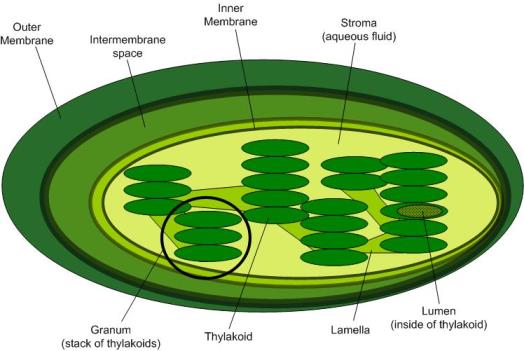What's for dinner?
Narcissus pseudonarcissus is an
autotrophic organism, meaning that it makes its own food
instead of relying on other organisms for nutrition. The
specific process that allows the daffodil, as well as other
plants, to receive necessary nutrients is called photosynthesis.
Through the process of photosynthesis, light energy is converted
into chemical energy in the leaves of the plant. This processes
occurs in two stages: the light reactions and the dark
reactions.
The light reactions occur in the thylakoid stacks of the grana, which are located in the daffodil's chloroplasts. Light energy is absorbed by chlorophyll and then converted, through several steps, into ATP, NADPH, and oxygen. The plant's stomata then release the oxygen into the air.
Continuing on in the process of
photosynthesis, the dark reactions are centralized
in the stroma, the liquid-like matrix inside a
chloroplast. The overall reactions are called the
Calvin cycle, or carbon fixation. The ATP and NADPH
from the light reactions convert carbon dioxide into
a six-carbon sugar. This sugar is then broken down
into glucose and fructose, which make sucrose, or
sugar for the plant. In order to store the sugar for
use, it is held inside the plant's cells and moved
to the mitochondria when necessary. The overall
chemical reaction equation for photosynthesis is:
6CO2 (carbon dioxide) + 6H2O (water) + light energy
--> C6H12O6 (glucose) + 6O2 (oxygen).
To obtain necessary water, Narcissus pseudonarcissus utilizes water from the ground, which is drawn up into the plant through its roots. Once the water is within the roots, the daffodil puts its xylem to use. Xylem is a system of vessels through a vascular plant that allows water to be pulled up from the roots and distributed to different parts of the plant. Phloem is another system of important vessels in daffodils, as well as other plants. Phloem is the transportation system for dissolved nutrients required by the plant, and these solutes are pushed up through tiny tubes as well. Thus, water and nutrients reach every part of the daffodil, nourishing it and providing "food." Both the xylem and phloem serve as the daffodil's circulatory system, with water and nutrients moving up, while sugars are moved down to the plant's roots.
Daffodils require soil that is slightly acidic, and that is well-drained. If there is too much water surrounding the daffodil's bulb, its roots will either rot or become very weak, making the plant less likely to survive and receive the nutrients it needs.
To obtain this nutrition effectively, daffodils also depend on mycorrhizal interactions with certain fungi that dwell in the soil. This important relationship can be explored in more detail on the interactions page.
Follow this link to revisit the homepage.
~ On the next page, learn how the wild daffodil reproduces. ~